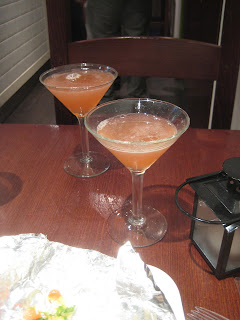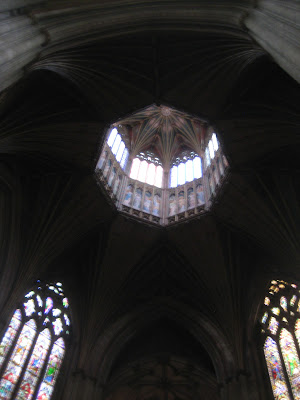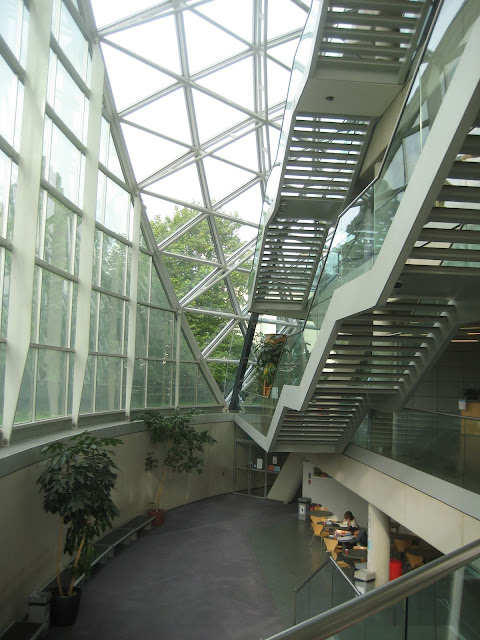Stop #9: Newnham College
Newnham College is one of the 32 colleges in the University of Cambridge - Jesus College and Kings College are two others. This college is only for women and was originally an all-female residence hall. The architecture is pleasing and gentle on the senses (that statement makes sense if you visit the college - it's an atmosphere thing). The grounds were reportedly very pretty, but the grounds were not as breathtaking as I thought they would be. I have a feeling that I didn't see them at the best time of year, so maybe I'll revisit later if I'm up that direction again.
 |
| The only hint of New England fall I've really seen. |
 |
| I have spent about 15 minutes trying to track down what this is, but I still have no idea. It looks awfully cryptic - perhaps the key to eventual world dominance? (Cody?) |
 |
| I am very proud of this picture, particularly since my mother is very good at taking pictures like this. I want credit for the in/out of focus effect! |
|
|
Stop #10: Silver Street Bridge
So there is this road named Silver Street.
And there is a bridge on it.
From which you can see
another bridge: the Mathematical Bridge.
Rumors fly around about this bridge quite often, and the main one states that the bridge was originally built to be held together by gravity, without nails. Students and Fellows later disassembled the bridge in a restoration project and were unable to put it back together correctly, so the bridge now has very conspicuous bolts at critical junctures. As much as I would love for this to be true, Queens College (which owns the bridge) asserts that the original bridge was built with iron pins or screws and the current bridge uses nuts and bolts. Actually, to quote from their website directly: "Only a pedant could claim that the bridge was originally built without nails."
......
Okay, what the heck is a pedant?
Leave it to Cambridge to throw a statement like that out there and make the engineers and scientists who actually enjoyed believing the rumor wonder if they just got majorly insulted without realizing it...
 |
| Oh yes - a pub. Very important in England, particularly for...well...just about everybody, actually. |
Stop #10: Mill Pond
Just upstream of Silver Street Bridge is a pond and falls that used to power a mill which straddled the Cam.
Stop #11: Trumpington Street
On the way to Trumpington Street, I found the place I sent all my application materials.
 |
| Ha! It DOES exist! |
 |
| Channels that used to flow fresh water into the city center many many years ago. |
Really? Channels? That necessitated an entire "stop?" Well okay - it's cool from an engineering perspective I guess... If you're getting bored, hang in there because the next site is more interesting.
Stop #12: St. Bene't's Church
My tour thus far had consisted of many older buildings, but most of them had fit in with the standard architectural style in Cambridge. But then, I arrived at THIS church: Anglo-Saxon in design and completed in 1033 A.D. I could see the distinct difference in architecture immediately - rectangular structures and simplistic decorations as opposed to the more ornate decorations and curved structures I was used to seeing.
 |
| Anglo-Saxon church on the left, normal Cambridge building on the right. See the difference? |
 |
| Original arch. The alternating long-short-long stone pattern was a trademark of the building style at the time. |
Okay, side tangent. I think I could have walked past this church numerous times during my year in Cambridge and never noticed that the architecture was different. I have found that there is a huge different between looking AT something and actually SEEING something. The audio tour that I was on brought me to the church and made me aware of the architectural differences. This is why I really enjoy commentaries (like the one at the Museum of Modern Art), because they take me from just looking at something - a building, gate, or piece of art - to seeing it in its full meaning and significance. There is a section from the book "Zen and the Art of Motorcycle Maintenance" that pertains to this idea. The main character is a rhetoric teacher for part of his life, and this section talks about a struggle he came up against in the classroom.
"He’d been innovating extensively. He’d been having trouble with students who had nothing to say. At first he thought it was laziness but later it became apparent that is wasn’t. They just couldn’t think of anything to say.
One of them, a girl with strong-lensed glasses, wanted to write a five-hundred-word essay about the United States. He was used to the sinking feeling that comes from statements like this, and suggested without disparagement that she narrow it down to just Bozeman.
When the paper came due she didn’t have it and was quite upset. She had tried and tried but she just couldn’t think of anything to say.
He had already discussed her with her previous instructors and they’d confirmed his impressions of her. She was very serious, disciplined and hardworking, but extremely dull. Not a spark of creativity in her anywhere. Her eyes, behind the thick-lensed glasses, were the eyes of a drudge. She wasn’t bluffing him, she really couldn’t think of anything to say, and was upset by her inability to do as she was told.
It just stumped him. How she couldn’t think of anything to say. A silence occurred, and then a peculiar answer: “Narrow it down to the main street of Bozeman.” It was a stroke of insight.
She nodded dutifully and went out. But just before her next class she came back in real distress, tears this time, distress that had obviously been there for a long time. She still couldn’t think of anything to say, and couldn’t understand why, if she couldn’t think of anything about all of Bozeman, she should be able to think of something about just one street.
He was furious. “You’re not looking!” he said. A memory came back of his own dismissal from the University for having too much to say. For every fact there is an infinity of hypotheses. The more you look the more you see. She really wasn’t looking and yet somehow didn’t understand this.
He told her angrily, “Narrow it down to the front of one building on the main street of Bozeman. The Opera House. Start with the upper left-hand brick.”
Her eyes, behind the thick-lensed glasses, opened wide.
She came in the next class with a puzzled look and handed him a five-thousand-word essay on the front of the Opera House of the main street of Bozeman, Montana. “I sat in the hamburger stand across the street,” she said, “and started writing about the first brick, and the second brick, and then by the third brick it all started to come and I couldn’t stop. They thought I was crazy, and they kept kidding me, but here it all is. I don’t understand it.”
Neither did he, but on long walks through he streets of town he thought about it and concluded she was evidently stopped with the same kind of blockage that had paralyzed him on his first day of teaching. She was blocked because she was trying to repeat, in her writing, things she had already heard, just as on the first day he had tried to repeat things he had already decided to say. She couldn’t think of anything to write about Bozeman because she couldn’t recall anything she had heard worth repeating. She was strangely unaware that she could look and see freshly for herself, as she wrote, without primary regard for what had been said before. The narrowing down to one brick destroyed the blockage because it was so obvious she had to do some original and direct seeing.
He experimented further. In one class he had everyone write all our about the back of his thumb. Everyone gave him funny looks at the beginning of the hour, but everyone did it, and there wasn’t a single complaint about “nothing to say.”
In another class he changed the subject from the thumb to a coin, and got a full hour’s writing from every student. In other classes it was the same. Some asked, “Do you have to write about both sides?” Once they got into the idea of seeing directly for themselves they also saw there was no limit to the amount they could say. It was a confidence-building assignment too, because what they wrote, even though seemingly trivial, was nevertheless their own thing, not a mimicking of someone else’s. Classes where he used that coin exercise were always less balky and more interested."
My problem is not so much that I needed to forget what was said before, but that I don't even know what was said before to begin with! Every time my eyes are opened by information in a pamphlet, a conversation with a friend, or commentary in my iPod, I realize the truth in the saying, "knowledge is power."
There were two more stops on the trip (in case you're following on the map), but I don't think they are worth recounting at the moment. So, I shall end my record here.



























































